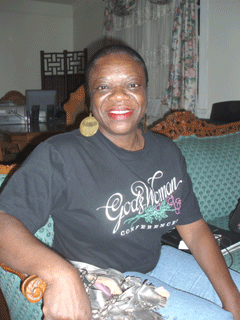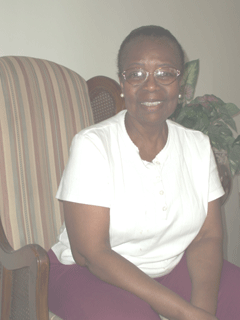Longing for New Orleans
Air Date: Week of October 5, 2007

Houses like these blight Rev. Dejean's Gert Town neighborhood (Photo: Ingrid Lobet)
Between thirty and forty percent of New Orleanians have not returned to the city since the levees failed in 2005. Some have found better lives elsewhere, but many yearn to come back. Living on Earth’s Ingrid Lobet has a portrait of one family’s struggle to return to their beloved city.
Transcript
CURWOOD: It’s Living on Earth. I’m Steve Curwood. When you talk with some folks from New Orleans, whether recently returned or living far away, you can’t help but be struck by a deep current of pain just below the surface. Two years after the floods caused by the failed levees, the webs of human relationships that bring life joy, or make a neighborhood a neighborhood, are still in shreds. There are those Katrina exiles who have found better circumstances elsewhere and settled down. But many city natives say they want badly to return, but can’t. As part of our continuing coverage of the aftermath of the Gulf Coast disaster, Living on Earth’s Ingrid Lobet gathered these impressions.
LOBET: Pam Landrum emanates energy, despite some trying times. She was raised on the adage: ‘Fault finders are not fault correctors,’ so even all these years later, her conversation contains more praise than protest. And one person she can’t praise enough is Houston mayor Bill White.
LANDRUM: I’m telling you, I kept up, and I watched the compassion in this man. If I ever have a chance to meet him, I’m going to tell him ‘thank you.’
LOBET: Landrum, with two little grandchildren by the hand, spent three days in the New Orleans Superdome without food or a bath before a bus arrived and Mayor White welcomed them across the Texas state line.
LANDRUM: He’s going to go down in history for the care that he had for the people. He opened his doors and said, ‘bring those buses, 300 of them, to us.’ That is ama—what a great heart, for a person to have that: ‘I’m going to take care, I’m going to take you in distress.’

Pam Landrum (Photo: Ingrid Lobet)
LANDRUM: I took my money and I went to school. Sometimes I’d stay at school ‘til ten o’clock at night. I just had to get my purpose; I had to go back to what my purpose was.
LOBET: In the evenings after class, there was a sea of need. There was Pam’s daughter with two young children, and an elderly aunt, all of whom had also landed, like so many raindrops, in Houston. Then at the end of each week on Friday, Pam drove the six hours back to New Orleans where her mom had now returned after the storm, but was alone. And where new drywall, new fans and new speakers, had brought the sweetness back into Sunday at Ebenezer Missionary Baptist Church.
[EBENEZER MISSIONARY BAPTIST CHURCH SINGING, “VICTORY IS MINE”]
LOBET: But those brief weekend visits in New Orleans, for Pam’s mother, Reverend Lois Dejean, were no substitute for having her daughter and the rest of her family around her every day, as she’d been accustomed.
DEJEAN: If something should happen to me, who do I call? When your family is usually here to take care of you, but it’s not. I remember I had to go to the doctor to get a procedure done on me a couple of weeks ago, and my daughter was in Houston, and my granddaughter was in Houston, so I had to call one of the other young ladies in my church. And that was fine, but it would have been better if I’d had my children. I’m 71 years old—don’t you think I want my children around me? Just knowing they are around is comforting.

Reverend Lois Dejean is Associate Pastor at Ebenezer Baptist Church, directs the Gert Town Revival Initiative, organizes the annual "Rejoicin in the Park" Gospel festival and leads a youth choir. (Photo: Ingrid Lobet)
DEJEAN: We went to bed at six o’clock in the evening, (snorts, laughing) and the only place you can go every day is to Wal-Mart (laughs). So that’s where I went everyday was to Wal-Mart. That was seven miles from the house so you went seven miles to Wal-Mart and you come back home. You look at television. It was just killing me because I’m not a person to just sit down and look at television all day long.
LOBET: So as soon as she could find a place to rent—she’s never owned a home- Reverend D came back. But now, her gospel students were scattered. Her neighborhood, Gert Town, was wrecked. And so, rather than returning to the joy of her youth choir, she waded into the proverbial muck to rebuild her neighborhood.
[DOOR OPENING]
DEJEAN: Let me show you part of it
LOBET: Reverend D sits down at her computer and opens a PowerPoint file with photos of every property—distressed, destroyed, or repaired—in her neighborhood.
DEJEAN: We took a picture of every house, every empty space. Every thing in Gert Town, we took a picture of it.

Houses like these blight Rev. Dejean's Gert Town neighborhood (Photo: Ingrid Lobet)
DEJEAN: Oh let me tell you something, those students who did this, I love them.
LOBET: The students are helping Reverend D rebuild a neighborhood anchor—Miss Gloria’s, the dollar breakfast place on the corner. And with her damaged community now digitized, she says it’s easier to work through the city bureaucracy.
DEJEAN: I have such great passion for where I stay. It is my dream to see Gert Town become a viable community.
LOBET: But what’s true for Reverend D is true for many older people in the city these days. This wasn’t how she planned to spend these years, far from family, fielding calls from other elders in need, even testifying before Congress. And she’s exhausted.
DEJAN: I’m just tired. I’m extremely tired. I deserve the right to grow old, to finish growing old with things I want to do, not things that I got to do, like I got to get on it, I got to be, I got to—no.
LOBET: Knowing her mom is tired was stressful for her daughter Pam, in Houston, too. The family was still adjusting to going, overnight, from one that had lived close, for generations, to one that was sprinkled from Dallas to Nashville.
LANDRUM: It was very distressful for all of us to be broken up. It feels like a person died. That’s what it feels like. It feels like you miss something. That’s the best way I can describe it is—like a death.
LOBET: A death that’s a collective experience, somehow.
LANDRUM: When there’s a death and it’s localized in your house, then you have friends and you have other things you try to pull from. When everybody is experiencing the same thing—where are you getting your strength from? You know, because you want to tell the other person, ‘I need help right here, you know, I need my friend.’ But you know they are going through maybe not the same thing but they’re going through something like that. And the other thing that we experience so much is physical death, a lot of people are dying from stress, stress-related, so when you want to share, you think twice because you say—what are they going through? So it becomes harder to do that and harder to keep your network together.
LOBET: Pam says among the people she knows, there’s no bigger topic than how to get back to the city.
LANDRUM: I’m telling you, it’s huge. Because there’s no other place like New Orleans and most people feel comfortable in New Orleans. Because we have—our food is different, there are ways we communicate. Communication, believe it or not, we came home to vote and everybody was out at the voting poll saying ‘Hey!! How you doin?’ We don’t know each other! You’re just accustomed to speaking, ‘hi!’ I mean even if you pass someone—this is our custom—if you pass somebody you don’t know: ‘How you doin?’ or ‘Good morning!’ You get in an elevator full of people: ‘Good morning.’ I mean you were taught that—I mean, your mom chastised you if you went somewhere and there was a group of people there and you didn’t speak. But in other places you speak and people want to know—‘what’s your problem?’ or ‘what do you want?’ And so people want to come home for those different reasons, so they can relax.
LOBET: The cultural repercussions of such deep dislocation may be deep as well. New Orleans is known as a place that gave birth to jazz. The city also has a strong gospel tradition. Many local musicians come up through the church and are first schooled in gospel. And Pam’s family is a perfect example of that New Orleans musicality: nearly everyone plays music. The family has a gospel group that performs at Jazzfest. Her mother teaches gospel. And her brother Eddie is a drummer who’s experimented with gospel, funk, boogie woogie. In other words, the kind of innovation the city is known for.

Eddie Dejean (Courtesy Eddie Dejean)
LOBET: With so many churches now empty, and families like the Dejeans consumed with economic survival, some have wondered whether the gospel circle will remain unbroken.
Music historian Lynn Abbot, in notes written after the storm, asks: ‘Will the little community churches that provide the necessary context for a viable gospel tradition in New Orleans manage to overcome the wandering in the wilderness, that has yet to subside? Will the likes of the Zion Harmonizers, the Spiritualettes, the Bemiss Brothers, the Melody Clouds, the Mighty Chariots, be able to maintain continuity? The fragile nature of our cultural heritage has been laid bare for all to see. Keeping it together is going to require a full measure of prayer and social commitment.’
Pam Landrum says for her, it was prayer, finally, that yielded results, when she was finally able to find a truck to borrow long enough to move her belongings back from Houston to New Orleans.
[SOUND OF PAGES TURNING AND LANDRUM TALKING]
LOBET: She kept track of all the agencies where she was turned down for a truck or the money to rent one—on three densely written 8.5 x 11 notebook pages.
LANDRUM: Oooh, there’s Houston, the Red Cross of Houston, Ooooh, Lord have mercy, I mean, Louisiana rebuilding, the Business Incentives, the S-C-I-C, I got all kind of stuff, City of New Orleans. Three months, three months.
LOBET: Pam usually has a smooth singer’s voice. But the move has her tired and her voice is strained. What she worries about now, besides finding a job, is her daughter and her aunt, still in Houston, and without much support.
LANDRUM: My aunt is in her seventies—that’s my mother’s oldest sister. She was crying every day, every day since Katrina, to come home. This is the only place she knew. This is a woman in her 70s. She cried so one day I mean I had a headache the whole day because it upset me so.
SHORT: People want to come home. People want to come home and the people who are not here, it’s not because they don’t want to be, it’s because they haven’t been given the opportunity to come back.
LOBET: Sabrina Short works with an interfaith group called All Congregations Together that helps religious communities mobilize. She says the Dejean-Landrum family’s experience is hardly unique. One thing she sees, even people with strong mutual support networks, is that they’re struggling to get their housing situation settled.
SHORT: It constantly came up that people are unable to rebuild: ‘I can’t rebuild because I don’t have money, I can’t rebuild because I am paying a mortgage on a house that doesn’t exist. I can’t even do anything with my home because my insurance is in jeopardy of getting cancelled.’ So there’s so many problems regarding rebuilding. And of course we are resilient. We’re going to try to rebuild with or without government help. We’ve done it before; we’ll do it again. But there are so many people, like our elders, who just don’t have the energy. We have low-income families who just don’t have the ability to take out a reconstruction loan and rebuild their house with $150,000.
LOBET: New Orleans, before the flooding of 2005, was a city where nearly 60 percent of people rented. Rents across the city have doubled and even tripled since Katrina. That’s a major barrier for many former residents. And yet Sabrina Short says when her church umbrella group began contacting people of the least means, people who had lived in public housing projects before Katrina, she was surprised by what she heard.
SHORT: What we found they were still in contact with each other, they still had each other’s numbers, they still called each other, and they were all over the country. Our people need help and it’s not people who are taking advantage of the system, it’s not people who are stealing from the government, or manipulating the system. It’s people who have a right to return.
LOBET: The right to return. You hear people here talk about it. It’s a right recognized by the United Nations, but not the United States. ‘Competent authorities,’ say the UN guidelines on internally displaced people, ‘have the primary duty to establish conditions, and provide the means, which allow internally displaced persons to return, in safety and with dignity, to their homes or places of habitual residence.’
Pam Dashiell is a community leader in Holy Cross, an African-American neighborhood that had high home ownership before the flood. She is blunt about the fact that New Orleans has lost many of its black people.
DASHEILL: To me that’s the crux of it all. I mean, there has been no organized effort to reach out and find us, to find the people who were dispersed. These are citizens of the United States. There should be an organized effort to recruit people back, to find us, and to get us back home.
LOBET: It’s common for people to trace their families’ roots here back to before the Louisiana Purchase, to plantation times, to slave times. Let that count for something, they ask now.
For Living On Earth, I’m Ingrid Lobet in New Orleans
[EBENEZER MISSIONARY BAPTIST CHURCH CHOIR SINGING “AMAZING GRACE”]
Links
Sound of New Orleans: Artist Booking Service
Living on Earth wants to hear from you!
Living on Earth
62 Calef Highway, Suite 212
Lee, NH 03861
Telephone: 617-287-4121
E-mail: comments@loe.org
Newsletter [Click here]
Donate to Living on Earth!
Living on Earth is an independent media program and relies entirely on contributions from listeners and institutions supporting public service. Please donate now to preserve an independent environmental voice.
Newsletter
Living on Earth offers a weekly delivery of the show's rundown to your mailbox. Sign up for our newsletter today!
 Sailors For The Sea: Be the change you want to sea.
Sailors For The Sea: Be the change you want to sea.
 The Grantham Foundation for the Protection of the Environment: Committed to protecting and improving the health of the global environment.
The Grantham Foundation for the Protection of the Environment: Committed to protecting and improving the health of the global environment.
 Contribute to Living on Earth and receive, as our gift to you, an archival print of one of Mark Seth Lender's extraordinary wildlife photographs. Follow the link to see Mark's current collection of photographs.
Contribute to Living on Earth and receive, as our gift to you, an archival print of one of Mark Seth Lender's extraordinary wildlife photographs. Follow the link to see Mark's current collection of photographs.
 Buy a signed copy of Mark Seth Lender's book Smeagull the Seagull & support Living on Earth
Buy a signed copy of Mark Seth Lender's book Smeagull the Seagull & support Living on Earth

